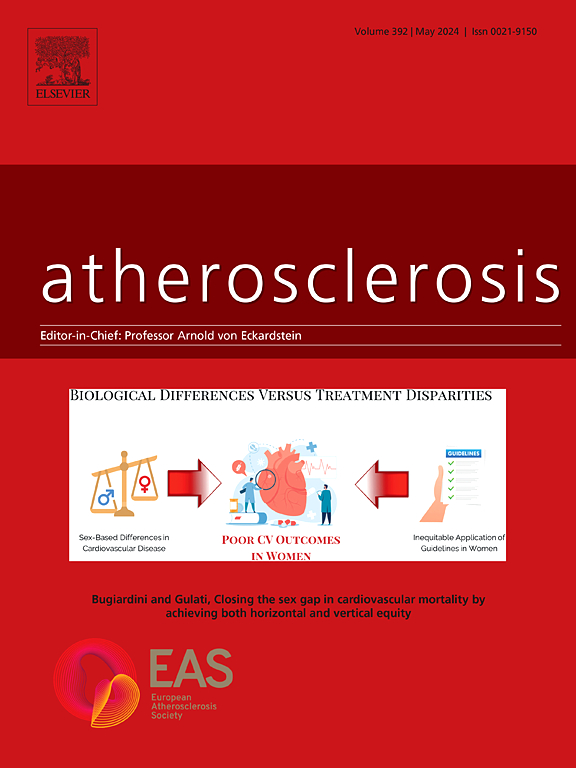BAM15 inhibits endothelial pyroptosis via the NLRP3/ASC/caspase-1 pathway to alleviate atherosclerosis
IF 4.9
2区 医学
Q1 CARDIAC & CARDIOVASCULAR SYSTEMS
引用次数: 0
Abstract
Background and aims
Atherosclerosis (AS) is a chronic inflammatory disease contributing to major cardiovascular events. This study aimed to investigate the effects of BAM15, a mitochondrial uncoupler, on regulating the NLRP3/ASC/caspase-1 signaling pathway to suppress endothelial cell pyroptosis and mitigate AS.
Methods
AS was induced in ApoE−/− mice through a high-fat diet (HFD), and the therapeutic effects of BAM15 (5 mg/kg/day, s. c.) were evaluated. Histological analyses, including HE staining and oil red O staining, were used to assess aortic pathology and lipid deposition. Serum inflammatory cytokines (IL-1β, IL-18) were quantified by ELISA. Mouse primary aortic endothelial cells (MAECs) were treated with oxidized low-density lipoprotein (ox-LDL) to simulate AS condition in vitro. Mitochondrial reactive oxygen species (mtROS) expression and oxidized (ox)-mtDNA content were detected by Mitosox staining and ELISA, respectively. Western blot was used to assess the expression of pyroptosis-related proteins, including GSDMD-NT, NLRP3, ASC, and cleaved-caspase-1.
Results
BAM15 reduced atherosclerotic plaque formation, lipid deposition, and inflammation, and diminished mtROS expression and ox-mtDNA content in the AS mouse models. In both in vivo and in vitro experiments, BAM15 markedly inhibited the activation of the NLRP3 inflammasome, leading to reduced pyroptosis in endothelial cells. Activation of the NLRP3/ASC/caspase-1 signaling pathway by Nigericin partially reversed the protective effects of BAM15, underscoring the pivotal role of NLRP3 inflammasome inhibition in endothelial pyroptosis suppression.
Conclusions
BAM15 effectively inhibits endothelial cell pyroptosis by reducing mtROS production and ox-mtDNA release to suppress the NLRP3/ASC/caspase-1 signaling pathway, thereby alleviating AS in both in vivo and in vitro models.

BAM15通过NLRP3/ASC/caspase-1途径抑制内皮细胞焦亡,缓解动脉粥样硬化
背景和目的动脉粥样硬化(AS)是一种慢性炎症性疾病,可导致主要的心血管事件。本研究旨在探讨线粒体解偶联剂BAM15通过调节NLRP3/ASC/caspase-1信号通路抑制内皮细胞焦亡,减轻AS的作用。方法通过高脂饮食(HFD)诱导ApoE−/−小鼠sa,并评价BAM15 (5 mg/kg/d, s c)的治疗效果。组织学分析,包括HE染色和油红O染色,用于评估主动脉病理和脂质沉积。ELISA法测定血清炎症因子(IL-1β、IL-18)含量。用氧化低密度脂蛋白(ox-LDL)处理小鼠原代主动脉内皮细胞(MAECs),模拟体外AS状态。分别采用Mitosox染色法和ELISA法检测线粒体活性氧(mtROS)表达和氧化(ox)-mtDNA含量。Western blot检测焦热相关蛋白的表达,包括GSDMD-NT、NLRP3、ASC和cleaved-caspase-1。结果bam15降低AS小鼠模型动脉粥样硬化斑块形成、脂质沉积和炎症,降低mtROS表达和ox-mtDNA含量。在体内和体外实验中,BAM15均能显著抑制NLRP3炎性体的激活,导致内皮细胞焦亡减少。尼日利亚菌素激活NLRP3/ASC/caspase-1信号通路部分逆转了BAM15的保护作用,强调了NLRP3炎性体抑制在内皮细胞焦亡抑制中的关键作用。结论bam15通过减少mtROS的产生和ox-mtDNA的释放,抑制NLRP3/ASC/caspase-1信号通路,有效抑制内皮细胞焦亡,从而在体内和体外模型中减轻AS。
本文章由计算机程序翻译,如有差异,请以英文原文为准。
求助全文
约1分钟内获得全文
求助全文
来源期刊

Atherosclerosis
医学-外周血管病
CiteScore
9.80
自引率
3.80%
发文量
1269
审稿时长
36 days
期刊介绍:
Atherosclerosis has an open access mirror journal Atherosclerosis: X, sharing the same aims and scope, editorial team, submission system and rigorous peer review.
Atherosclerosis brings together, from all sources, papers concerned with investigation on atherosclerosis, its risk factors and clinical manifestations. Atherosclerosis covers basic and translational, clinical and population research approaches to arterial and vascular biology and disease, as well as their risk factors including: disturbances of lipid and lipoprotein metabolism, diabetes and hypertension, thrombosis, and inflammation. The Editors are interested in original or review papers dealing with the pathogenesis, environmental, genetic and epigenetic basis, diagnosis or treatment of atherosclerosis and related diseases as well as their risk factors.
 求助内容:
求助内容: 应助结果提醒方式:
应助结果提醒方式:


